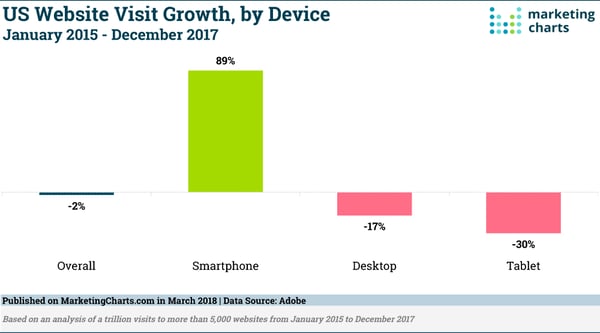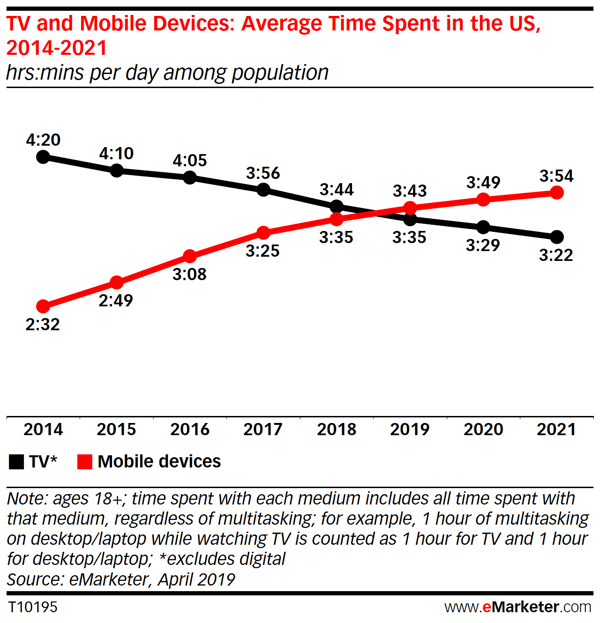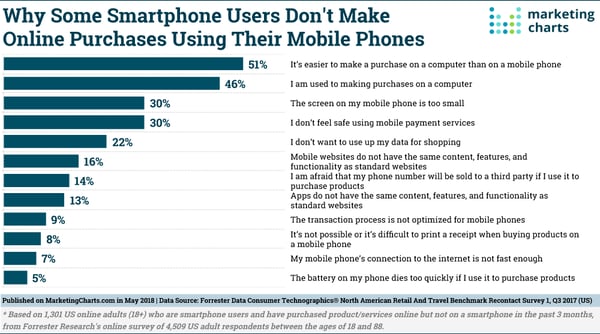Google saw the future and it's mobile. That means mobile search on smartphones is where it's going and you need to be ready.

The State of Mobile
In a recent report that hammers home the insight Google's team found last year, Adobe found that It’s true that smartphones still account for only a minority (39%) of website visits in the US as of December 2017. However, with that figure likely to continue growing for the time being, the focus will likely continue shifting to smartphones.Meanwhile, the importance of a strong user experience on smartphones is brought further to light by data in the report showing that "visits from these devices are getting shorter. Between January 2015 and December 2017 visit time on smartphones declined by 7.3% and pages per visit by 8.6%. That leads the analysts to note that consumers are becoming accustomed to an optimal, efficient experience and that websites need to mind the shorter attention span and decreased tolerance for useless steps.”

On an encouraging note, smartphone visits are slowly becoming more valuable relative to desktop ones.In 2017, 57% of all search traffic came from a mobile device or tablet and smartphone revenue per visit was about 30% that of desktop revenue per visit. While that may seem low, it’s a considerable improvement from January 2015, up by 11% points. More importantly, the rate of growth projected will have mobile search and purchase dominating before we know it.
The analysis found that mobile phones were the “initial touch” device 40% of the time, just ahead of desktops (37%). That’s consistent with previous research indicating that smartphones are the primary device for launching shopping journeys.
Where phones really shine, however, is in moving the process along: mobile phones were used as the intermediary touch (neither the first nor the last touch) some 58% of the time!
This suggests a better experience on smartphones and more comfort with ordering products and services on these devices. That’s supported by recent data from Yes Lifecycle Marketing, which found that for the first time last year, email-driven conversions (orders per click) on mobile devices reached parity with desktops.
A Strategy to Become Mobile First-Indexing Ready
So what exactly does this mean for developing search engine optimization strategies for your outdoor brand? It means if you don't want to see your competitors zoom ahead of you, need to make it a priority to be mobile first-indexing ready.
Currently, search engines crawl the desktop version of a website in order to index and rank that site for SERPs. What you might not know though, is that this won’t be the case much longer with the introduction and rollout of Google’s mobile-first indexing. This isn't exactly new though, with Google first announcing that it would be experimenting with a mobile-first index in 2016 and finally starting to roll it out this past March. Google's overall thinking is to improve the mobile user’s search experience, helping them to better find what they need faster.
Most mobile searches are done through Google (over 90% of them!). It’s important to note that when Google says mobile, they mean smartphone. Google excludes tablets from the mobile category and that “unless you offer tablet-optimized content, you can assume that users expect to see your site as it would look on a desktop browser”. There won’t be separate indexes for desktop and mobile, so you’ll need to make sure the mobile version of your website is ready.
Optimize for Local
Optimizing your website for local is essential, especially since 76% of people who search for something will visit a related business within a day. You can take advantage of all the “near me” searches in a number of ways. Building up local links, adding photos and making sure all of your information is updated in Google My Business are some things you can do if you haven’t already. You should also craft content with a local focus and as always, keep it relevant and interesting for your user.
Even more, consumers trust online reviews as much as personal recommendations. Positive online reviews can help you sell products, or it can inspire trust from a customer sharing the positive experience they had at your store. It's no surprise that consumers and businesses are turning to Google to get recommendations and referrals.
Your dealers are all based in some local search area. It is important that their business is being optimized for local search. Optimizing for organic search is obviously extremely important, but it is great to have that additional way for others to find their website and locate your products they carry. To maximize the partnership you have with local brick and mortar retailers, it is critical that they are set up in Google to be found.
What's Holding Mobile Back from Even Greater Adoption? Mobile User Experience.
Website configuration is crucial. A recent report from Forrester Research indicates some of the reasons why people don't shop more on mobile. The majority of the reasons are fundamentally, website configuration challenges.

Final Thoughts
The mobile challenge is another one of those brutal facts you have to face while adhering to your overall positioning plan and maintaining a strong desktop presence because mobile conversion rates are still lower than desktop conversion rates – which explains why Adobe data shows that currently, retailers earn 4 times more from a desktop than smartphone visit. (It is worth noting, however, that there are indications that the mobile shopping experience is improving, leading to higher conversion rates). Every piece of data points to the continuing march upward for mobile in representing more searches, purchase decision points of influence and final purchase points for more and more goods and services. While much of what you’re already doing with your search will still be applicable with mobile first-indexing, there are definitely some things you’ll need to change or slightly adjust.


